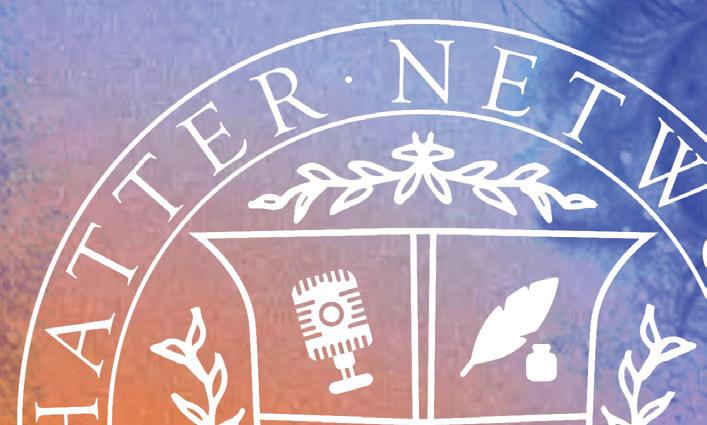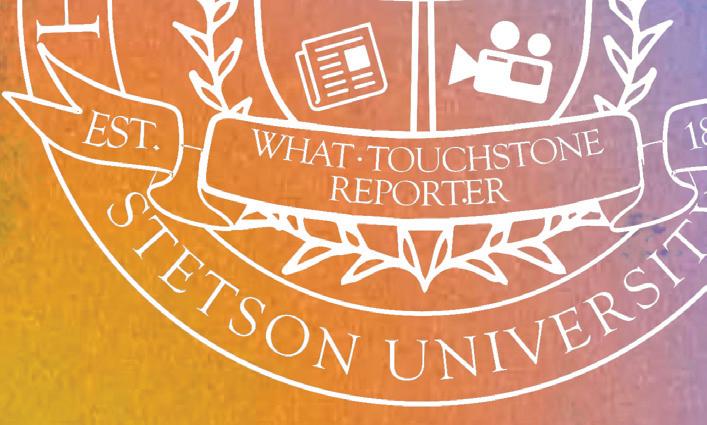










































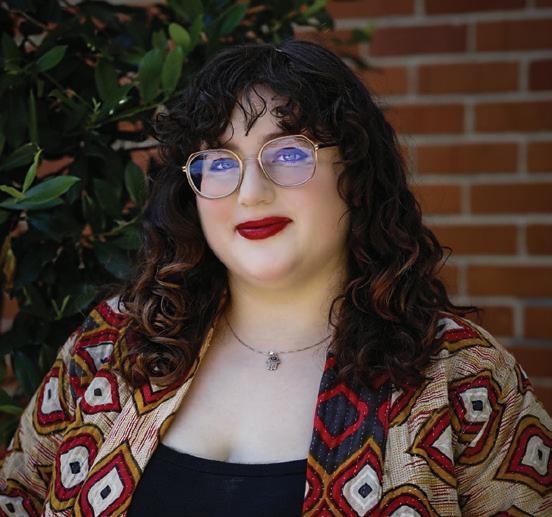









 Xanthippe Pack-Brown Editor-in-Chief
Carmen Cruz Executive Editor
Nkosi Watts Webmaster
Alexis Diamond Managing Editor
Hayden Collins Creative Director
Chase Berger News Editor
Xanthippe Pack-Brown Editor-in-Chief
Carmen Cruz Executive Editor
Nkosi Watts Webmaster
Alexis Diamond Managing Editor
Hayden Collins Creative Director
Chase Berger News Editor
StaffOther creative people.
Xanthippe Pack-Brown, Editor-in-Chief Hayden Collins, Creative Director








































Carmen Cruz, Executive Editor of The Reporter
Alexis Diamond, Managing Editor of The Reporter
My curiosity. Social





Logan Warren, Social Media Director for Touchstone
The beauty of everyday life.
The world around me!
Shapes and splashes of color.
Jillian Semmel, Photo Editor














Chase Berger, News Editor of The Reporter
Eleanor King, Sports Editor of The Reporter
Nkosi Watts, Webmaster
























Bella Steiert, Staff Writer
Brandy Bennet, Staff Writer
Carla M Rosario, Staff Writer
Carlye Mahler, Staff Writer
Cas Bradley, Photographer
Ciara Kelley, Staff Writer
Hayle Simone Morgan, Staff Writer
Kaelyn-Rose Miranda, Staff Writer Madison Sepiol, Photographer
Natalia Jimenez, Photograper
Nathan Biagianti,Staff Writer
Jackie Maze, Multimedia Editor
Seeing people enjoy each other’s company.

Songs inspire me to be creative.
Jordan,
Lisa Jordan, Executive Editor of Touchstone
Julexis Gonzalez, Associate Editor of Touchstone
Lane Davis, Executive Station Manager of WHAT Radio
When it comes to joining Hatter Network, we are never not excited about someone wanting to join our ranks. If you want to write, e Reporter is the place. If you like to appreciate art, music and writing, Touchstone Literary Arts Journal is where it’s at. If you want to create your own podcast, or learn how to use the tech in our radio station, WHAT Radio is there. Hatter Network is an extacurricular media program run by students, for students, to provide them with the information we think they need to know, or an outlet for their creative endeavors. If you’re interesed in getting involved, please email our Editor-in-Chief, Xanthippe Pack-Brown, at xpackbrown@stetson.edu or apply on Engage.


e Reporter, as part of Hatter Network, is the oldest collegiate magazine in the state of Florida. We publish four times per year, twice per semester. Florida Sun Printing prins 300 copies per isue on 8.5 x 11 inch, 80# Gloss Test, Most body text is set at 11 poind Adobe Garamond Pro or Times New Roman with 13 point leading set with a combination of regular, italic and bold. All pages are designed using Adobe Creative Suite Photoshop and Illustrator. For additional information please visit hatternetwork.com. Questions or concerns can be mailed to 421 N Woodland Blvd. Deland, FL 32723 or emailed to hatternetwork@gmail.com.
As we close out the Fall semester, we at the Reporter also re ect on all we’ve learned during our tenure on the e-board. We celebrate our successes, and we learn from our shortcomings. is season of growth for our department has been an exciting one, and has cultivated so much progress. We’ve made friends along the way, and forged stronger bonds with acquaintances. We both teach and learn from one another, ever fuelled by our passion for seeking knowledge and for literature. But as time closes in, and graduation day is catching up to us, I nd myself caught in a sea of mixed emotions.
On the one hand, my heart swells with pride at all we’ve accomplished, but on the other, I already nd myself missing this part of my journey.
But before this chapter comes to a close, I’m reminded that we still have another semester before us. Our work is far from complete. ere’s still much to do in the time we’ve been a orded, and we fully intend to utilize every minute of it so that we might serve this community of ours to the best of our abilities. As I think about this great adventure that lies ahead, and the many more that will soon follow, I can’t help but feel inspired.
Our rag-tag team of writers, many of them new additions to our team, have worked tirelessly to cultivate a comprehensive array of stories. From updates on the addition to Sage, to our take on the Try Guys drama, and even a spotlight on the Digital Arts department, we’ve pursued answers to questions that we think this community wants to know. We hope you enjoy it. Happy reading!
Carmen Cruz, Executive Editor

photoshop styles I love while also incor-




Coming to you live from the Hatter Network o ce, it’s your photographer extraordinaire (well I like to think I am haha!) or more commonly referred to as Hatter Network’s Photo Editor! I’m writing to you to spill all the hot behind the scenes information on how the photos you’re seeing on the photos for this feature story came to be! It all began with our sta members interviewing students and faculty in the Digital Arts department. I was then able to connect with our wonderful cover models Shamar Rush and Brielle Miller, who are featured in the article, and a er some communication, we headed to our dinky little studio under Flagler and went to work. I like to describe working in the studio as reminiscent of the early detention scenes from Lemonade Mouth. A er less than an hour, I had the raw images that would soon turn into the experimental and bold photos you see on these pages. I wanted to combine the creativity and experimentalism that we digital artists can achieve while also contrasting this with hyper detailed black and white portraits of actual digital artists represented in the article. It was a great opportunity to showcase the more out of the box photoshop styles I love while also incorporating my true love of portraiture. I hope you enjoy this issue as much as I have, and don’t forget to support the arts.
Jillian Semmel, Photo EditorWe’re back with our 3rd magazine publication this semester to grace your welcoming hands. Working on this edition has been a pleasure lled with laughs, curiosity, and fun. As we plotted our direction for this issue, we gathered ‘round with excitement as we listed current news reports and Stetson-based incidents that would be relevant for the university’s community. We ended up settling on some very diverse stories such as a piece on hurricane Ian, a business analysis of the Ned Fulmer and Adam Levine scandals, and most importantly, the plights of the DIGA department. While I have little knowledge of the DIGA department as a political science and communication major, I was interested to hear what students in that eld had to say about their experiences. Filled with interviews and expertise, we strived to grant our audience a full glimpse into the DIGA department, and the same can be said for our other stories for this issue. We hope you enjoy this edition as much as we had making it. I hate to sound like a broken record, but I really enjoy working with this team; I believe we all share the same drive to publish informative and entertaining material for the community, and a similar love for journalism. Although the semester is coming to a close, we hope you’ll stay with us through the end and continue into next semester. Cheers, and thanks for reading!
Alexis Diamond, Managing EditorIt is insane to me that we are already at our last issue for the Fall semester. is issue is full of so many awesome stories that I am so glad we get to share with you all. Being able to see the editorial team re ected in these past two issues is so special, and I am so proud of the beautiful work they have been making. As Carmen told me in one of our meetings, this issue is by the students, for the students, and we hope you enjoy it as much as we do. anks for sticking with us, and happy reading!




























 Model, Shamar Rush
Model, Shamar Rush

The Plight of the Diga Major A big program with very little
Love Sells... and Who’s Buying? Our take on the business of celebrity romance
The Reality of Hurricane Ian Piecing together the puzzle of what happened and why
Death Cab for Cutie Review
Our thoughts on the subdued bops in this mellow LP (it passed the vibe check)
Construction Complete: The Cici & Hyatt Brown Hall from Planning to Production
Unpacked: With Charles Issac Drummond
We sat with Cadet Captain of Army ROTC to unpack his FTX essentials
The Blurry Haze of Name Image Likeness


Unpacking the chaos and confusion
Ampersand Concerto Competition Winner Olivia Corporon
Prowling for Pizza: Our Take on the Best Classic Pie in Town
We scoured the streets of DeLand like gosh darn pizza rats to assemble our list for the best of the best
Scarcity, sabbaticals, and sta shortages are issues all too common amongst Digital Arts majors and minors alike. Stetson University has been revered for its accomplishments and expert faculty in regard to its Digital Arts department, even being named in the 2022 Princeton Review for Top 50 Game Design Programs. However, over the past few years, that expert faculty has begun to dwindle, as have the courses being o ered. As the program expands, it continues to attract more prospective students to the school, which has made the lack of resources, space, and sta all the more evident.
A multitude of things sets the Digital Arts Department apart from other programs at Stetson, although, among students, the most notable difference aren’t the accolades at all, but rather their severe lack of faculty. As of the Fall 2022 semester, the Digital Arts sta has dwindled down to only four professors: Chaz Underriner, Nathan Wolek, Matt Roberts, and Dengke Chen. Although, in the coming semester, Chen’s sabbatical will likely be yet another blow to the already short-sta ed department. Several Digital Arts students, especially seniors, have begun to notice the de cit of instructors, many highlighting the issue as one of the greatest weaknesses within the program.
Professor Und n also comm ted on his setba s w h the professor probl , noting, “As for professors, we have around 120 to 140 Di tal Arts majors, and Di tal Arts has only four professors; is defin ely a sou e of fru ration for us. We are pet ioning for more pos ions ev y year.”
- Ayd F re ‘23.

Seniors in the program now not only have to worry about completing their senior projects, but also about losing their mentor and access to someone knowledgeable in their chosen eld.
But this limited sta is not an isolated issue: it a ects every other aspect of the program. “We can hire an adjunct, and though being an adjunct is great and useful to people in di erent phases of their career, it is highly problematic as a way to sta classes,” Underriner explained. With adjunct professors, the department is alleviating an immediate need, though adjuncts can only do so much in their position. ey may stay for a few semesters, but their leave is inevitable. Not to mention, they are most likely teaching general or introductory courses, limiting the adjunct and students to potentially redundant and surface level instruction. Underriner continued, “It is necessary to ll a role, and hiring an adjunct is not going to resolve that long-term.”
This monochromatic orange moment breaks up the multicolored photos beside them while remaining eye-catching
“For me, we are needing more a or professors, ju because if one professor leaves, you don’t have a ass, because that is what his job is,”



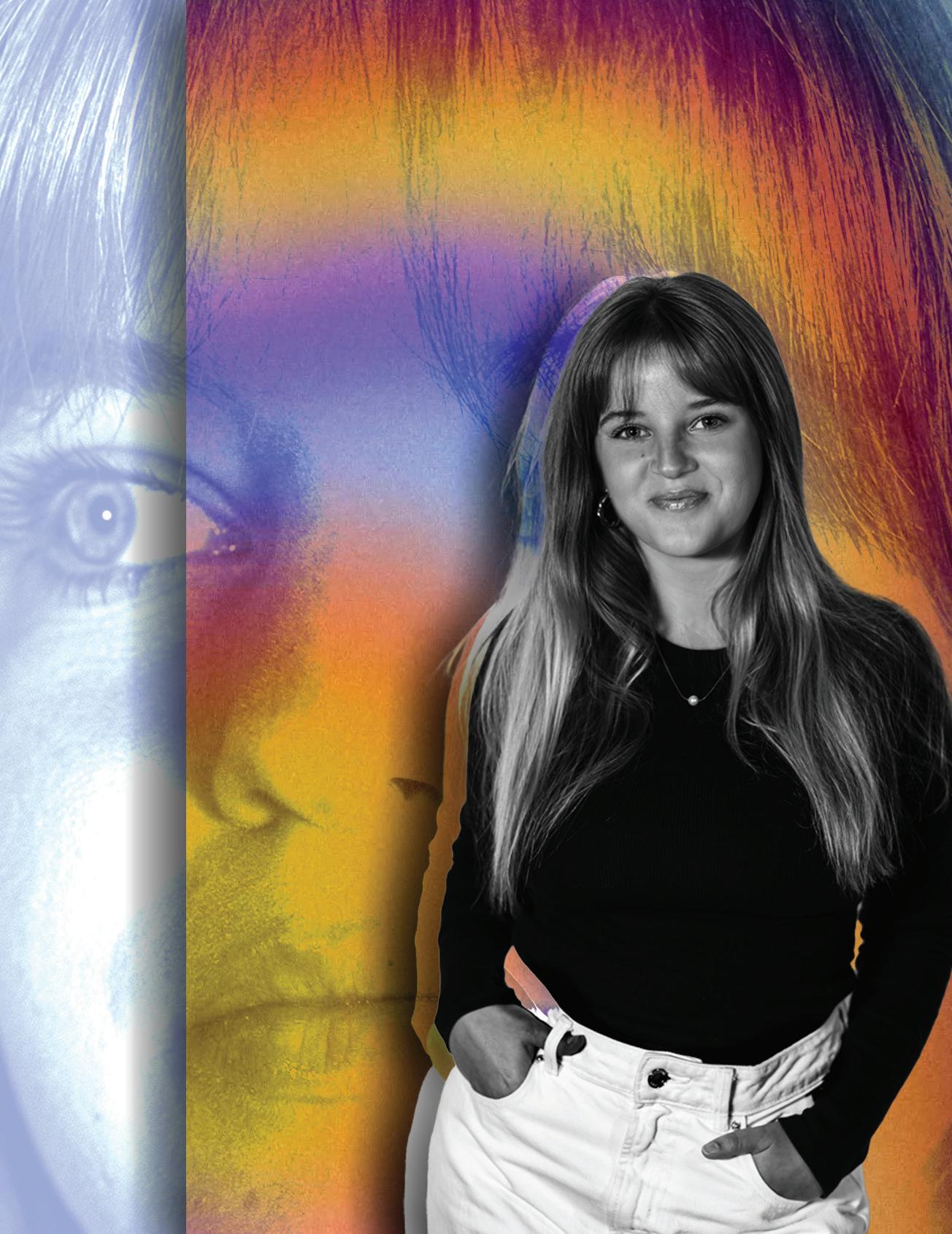

ough temporary or traveling faculty can be seen in other programs around campus, the Digital Arts department relies on some of these visiting professors or adjuncts to teach integral courses within the program, making the sta shortage not only a faculty issue, but a course issue as well. Brielle Miller ‘23 added, “ My graphic design class had a professor only there for one semester, so he couldn’t really fully immerse himself in what other classes involve. e syllabus overlapped a lot with the intro classes.”
“Th e isn’t too mu progression w h asses. Th e are only two asses: be nn and advanced. We’re done aft that. For the 3D Animation tra , th e’s only two asses you can take and the same w h the visual video asses.”


























- Shamar Rush ‘23

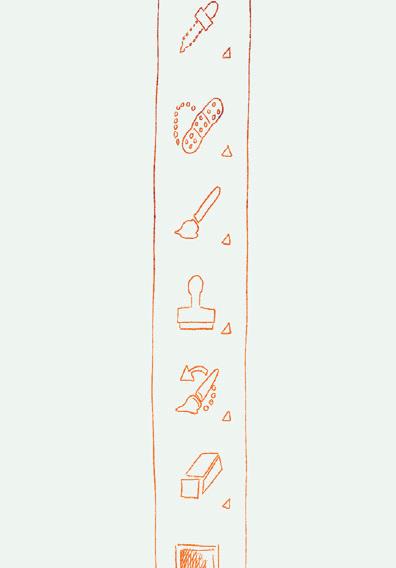


In terms of the courses themselves, the Digital Arts program falls at yet again. As Miller mentioned, graphic design is a huge source of frustration amongst students. It is one of the six main concentrations o ered for majors and minors, even being highlighted on the Stetson University website as one of the rst and most prominent courses in the Digital Arts track. However, the majority of the concentrations are limited to, at best, two classes.
Many Digital Arts students, especially more so on the visual arts side, are forced to limit their scope of interest to t with what the school can o er them, which proves extremely di cult for students that wish to pursue further education in one speci c eld. e Stetson institution as a whole pushes for a well-rounded education, evident in the multiple values courses present for all students. However, when it comes to the arts, students are learning fragments of a complete education. Miller added, “I think I have gotten a nice liberal arts education that will be good for me in the long term, but eventually, if I wanted to become more specialized, I think that I’d have to self teach a lot.” At least within Digital Arts, Stetson prioritizes the
With edits like this one, Photoshop seriously comes in handy and can be incredibly versatile for a digital artist!
concept of “well-roundedness” over being educated extensively in one subject, which results in many students having to seek further instruction elsewhere or wholly on their own. e thought process has good intentions, but these students are losing the opportunity to pursue what they want just because there aren’t enough classes to fully cover it, or again with professors, because there’s no one to teach it.

In addition to how few courses are being o ered, the program’s classes are extremely di cult to get into. “I teach digital audio fundamentals every semester and we have to o er a minimum of that twice per semester and still every time we o er it, we have people banging down our door trying to get into class, and that’s just how it is,” Underriner said. As the major continues growing and the sta keeps shrinking, the competition for classes only increases. “I wanted to take the fundamentals class and I couldn’t get in because it was so popular. And that was a class I was just dying to take, because I just wanted to know if I was truly interested. So I switched my major to get into the class,” Miller said.
Many students who may be interested in the program are forced to resort to all di erent ways to get into the courses. Another student, Briana Mehershahi ‘23, commented, “ I took it completely online which I think isn’t the best way to get into it, because it was over the summer and COVID was still a thing. I de nitely think a more hands-on approach is the way to go for these classes.” With major switches being so popular amongst college students, it is not unusual that many students within the Digital Arts program have transferred in either from other schools or other majors. ough, it is the way in which students must manipulate their schedules that stands out.
concept extensively subject, dents wholly intentions, tunity aren’t In program’s teach we banging that’s the to I because just was Many are ‘23, I de to popular that have majors. and attract
However, even with the understa ed department and limited resources, the department continues to attract and maintain the interest of the students. e majors and minors that make the program what it is continually attest to how dedicated the faculty is,
f dly vironm t. We are a pe s and are con antly pushing ea oth ,” Meh shahi said. It is evid t ju how support e the ud ts are of the program, ev w h their own qualms. the reporter 11
“It’s a
even if few in number. “I didn’t think I’d be so close to the professors. I switched my major when I was a sophomore and for the last three years, I have been really involved with them,” said Miller. While the department has competitive classes, Digital Arts at Stetson fosters a community of like-minded individuals, backed by professors that want to see their students succeed. “I think the program excels at community,” said Ferrell, adding “If you don’t know how to do something, you can nd somebody real quick who can teach you to do it.”
Although the issue remains of simply getting more resources to continue propelling the Digital Arts department on a forward facing trajectory. “I’d like to see the program in the future have more resources, facilities, faculty and support so students can have even more opportunities to do their work in the best way and get out into the world,” said Underriner. As noted, the pitfalls of the department are felt amongst most everyone involved and one of the main ways to combat it is to have more attention drawn to the issues. Elizabeth Skomp, Dean of the College of Arts and Sciences, said, “We would simply need to explore a little more deeply to understand how we could best meet the acute student needs as soon as possible.”
ere is talk of tentative plans in place to expand the Digital Arts program and accommodate the broadening interest, which could potentially alleviate a lot of the pressures of the major and accessibility issues.“I think that the most meaningful step that we can take

in the short term is to open up a second lab,” continued Skomp, adding that “Stetson is a small private institution that is tuition driven, tuition dependent even, we certainly always have to take resource constraints into account in any particular circumstance.”
And although the Digital Arts department may not be unique in its need for more resources, it does not make the demand any less important. In regard to resources and funding, Matt Roberts, a Digital Arts professor, said, “Sure, we receive 15 million, but not quite. We are not really getting full access to that 15 million. It is only for scholarships, so we can’t really use it for things we need like facilities. Lots of red tape.”
With so many elds the program is attempting to cover, a large sum of the students are vying for better tools and better access. “ e program just doesn’t get enough. I’m taking digital photography and all the cameras are rented from the library or donations; they are not new. at’s why I had to just buy my own,” said Ferrell. Monetary and access issues span each of the concentrations, though. If it is not a camera, it is “At Stetson, you can go to the labs and have access to mo things, but they don’t a ow you to a ua y have the program on your own comput , unless you pay for yourself. And I can’t a ord that,” said M l .
an iPad or a recorder. ough the department is receiving funding, and scholarships help several individuals, the longevity of the program requires resources that are not easily attained and a ordable for students.
What’s also interesting to note, however, is the disparity amongst the di erent concentrations within the Digital Arts department in regard to overall accessibility. ough the students themselves generally view the program as a supportive community, the resources a orded to certain sections of the department are telling. Many music and audio students give overwhelmingly positive feedback, especially in terms of resources, whereas there seems to be a lack within so many other concentrations. “ e stu we have access to is really wonderful, like the DAWs [digital audio workstations]. In Electronic Music and Sound Design we actually get to research and use di erent types of technology, like this brand new thing called Audio Stellar,” said Mehershahi. But on the contrary, other department students, especially those in graphic design and photography, have noted that their resources are more worn and in need of updating. Also notable is two of the Digital Arts professors specialize either fully or somewhat in audio, which gives reason for more resources and renovations being pushed for the audio concentrations. Again, much of the issue can potentially stem from the understa ed department as a whole, given there are no permanent or full-time visual Digital Arts professors advocating for equipment as of 2022.
Nonetheless, the Digital Arts Department may be lacking in multiple ways, but it is clear that the people are the lifeblood of the program: the professors, students and relationships shaped between them.
Based on general opinion, the department has the potential to continue to grow and excel, but needs the support of more faculty, more resources, and more access.

Skomp said, “I do think that th e’s an incred ly promising future for the program, especia y if we can augm t w h some add ional physical resou es.” The mo important task for the d artm t now is a matt of fulf ling the “if.”

Recent developments among famous icons in music and entertainment have contributed to this discussion of the marketability of romance. Their names have since gone down in infamy, having been associated with terms such as “cheater,” “liar,” and “manipulative.” Two of these men are Adam Levine of Maroon 5 and former Try Guys member, Ned Fulmer.
Having garnered the label as “the wife guy,” former Try Guys member, Ned Fulmer, has recently tested his contractual and marital limits with the year-long affair he had with an employee of the company: Alexandria Herring. As a result, his “wife guy” title has been revoked by fans, and his name has now become associated with mistrust. His online persona was built upon the happy marriage he and his wife had, which he so often emphasized, but now turns out, was a farce. Ultimately, his affair resulted in his termination from the company, but the reasoning behind this decision runs much deeper than a mere cheating scandal.
Herring is known on the Try Guys channel as a “Food Baby,” having participated in multiple segments on their YouTube channel trying different foods and participating in food-related challenges. Fulmer, at the time, was one of the CEOs of the Try Guys brand, which made Herring his subordinate;




 Written by Alexis Diamond Layout by Cas Bradley
Written by Alexis Diamond Layout by Cas Bradley











this added another complex layer to the situation, which I will dive deeper into later. Cheating is an inexcusable act, and Fulmer’s previous determination to capitalize on his supposed loyal marriage adds another layer of deception to the equation. Another “loyal” husband is Adam Levine of Maroon 5. A recent TikTok by Instagram model Sumner Stroh, revealed Levine’s infidelity with flirtatious messages sent on his behalf, as well as the disturbing request to name his baby after his mistress once they’re born if they happen to be male. Stroh expressed discomfort after receiving this question and exposed his messages shortly after. Levine later released a statement on his Instagram claiming that he “did not have an affair,” but “crossed the line” in what he deems a “regrettable period” in his life.
This case draws uncanny similarities to Fulmer’s scandal. While business is not a factor in Levine’s case, power differences are present in both scenarios. Fulmer is Herring’s boss, and Levine is a 43-year-old multi-millionaire musician, while Stroh is a 23-year-old Instagram model. There is a 20 year age gap between these two, and as evident by his net worth, there are financial disparities as well. These innate differences make this relationship more troublesome due to this power imbalance. Furthermore, fans were struck with the inevitable reality that the celebrities you see on screen are very different in real-life.

Romance sells in the world of Hollywood. By way of social media, celebrity relationships are publicized for our enjoyment; as evidenced through fans’ persistent shipping of couples.
In the world of business, your image is your brand, and it must be preserved. In Fulmer’s case, his claim to fame was his wife; I would argue his whole personality was his wife. Dr. Young, Stetson professor in the School of Business, argues the same. “They had this persona that they were safe bets and family men, and then they sold that idea to people… That is part of their identity and how they make their money” she states. Only in the world of Hollywood does marriage sell, and sly money makers like Fulmer are the connoisseurs of the idea that you can make your marriage your whole identity. References to her were nonstop from the beginning of the Try Guys to his eventual termination from the company; it was his entire claim to



fame. Tough realizations were made as to who Fulmer really was, and tragically, his wife had to pay the price.
As troubling as his scandal is, I find it deeply unsettling that this occurred between him, a CEO, and one of his subordinates. Herring, the woman he cheated with, was someone that Fulmer was responsible for hiring as oddly enough, he was the entire Human Resources (HR) department. Deana Lowry, assistant director of Wellness and Recreation at Stetson with a masters in HR, defines the HR department as a protector: “they’re
there to protect the company, protect the university, protect the brand.” They are commonly known to be a department that deals with the well-being of the employees alone, and according to Lowry, that’s a common misconception. According to the Occupational Outlook Handbook from the U.S. Bureau of Labor Statistics, “They oversee the recruiting, interviewing, and hiring of new staff; consult with top executives on strategic planning; and serve as a link between an organization’s management and its employees.” Fulmer was responsible for these things, meaning he held a lot of authority in the Try Guys brand. This fact added fuel to the fire.
While recounting the situation with Dr. Young, her business professional alarms blared signaling trouble that I’m sure all of you could detect early on. A boss and a subordinate in a relationship that only one has confirmed as being consensual equals lawsuits for “sexual harassment, quid pro quo, and also [a] hostile environment, like all of that wrapped up into one,” Dr. Young said. Herring has not filed any lawsuit against the Try Guys, but the possibility is always there for one in the future. Remember, Fulmer is the being consensual; Herring has made no official statements upon his release from the brand, and











only one who has attested to the relationship the status of her involvement in the Try Guys






















is also still up in the air. I won’t claim that this relationship was consensual or non-consensual, all I’ll say is that her story about this scandal is
just as important as his.
Those who don’t have experience in professional environments such as these may not be familiar


much understanding either. That’s where Dr. Young and Deana Lowry come in handy.
were made here (not criminally just morally):
being unfaithful to your wife amidst a pregnan-
cy—which is never easy, mind you—and doing it with a mistress who was only able to legally drink two years prior. What makes this situation all the more chilling is the fact that he wanted the baby his wife is still carrying to be named Sumner (after his mistress) if they happen to be male. Cheating itself is repulsive, but engaging in it while your wife is pregnant and then wanting to name your newborn baby after your mistress? I feel the only correct words for Levine in this situation are shame on you.
that “some places are like, ‘oh, just come and tell us and HR, sign a paper so we know that you’re both consenting to this relationship, and you’re not holding the organization accountable.’”






Dr. Young and Lowry both confirm that methods for handling these incidents are different depending on the workplace. Dr. Young states Lowry recounts a past experience at a differ-
ent job where a friend engaged in a workplace relationship, which was handled differently. “I had one friend who was dating a guy, and they worked in the same place, they weren’t allowed to, but they kept dating and they eventually took




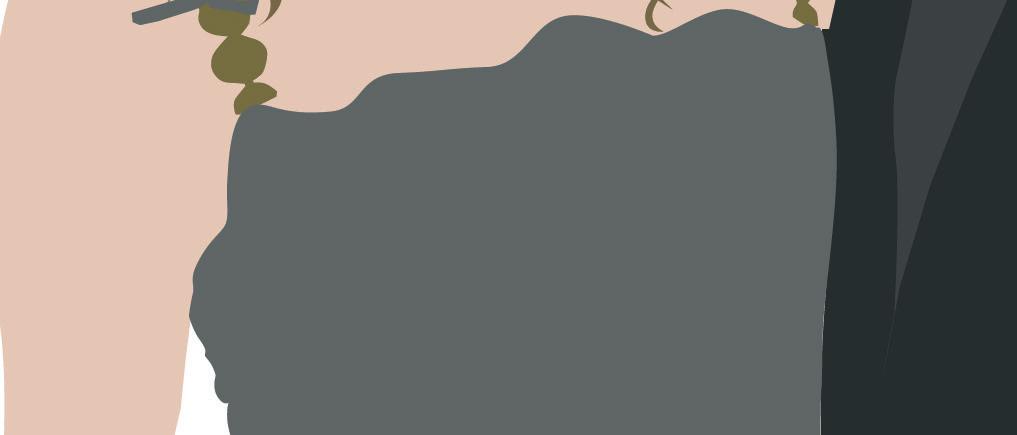

it to HR and said ‘you know, we’re together’ and they moved them to a different unit” she are used. But with the Try Guys being a more image-driven brand, Fulmer being fired is no surprise. By no means is Fulmer the only unfaithful man; Levine is another cheater we can add to the list of Hollywood scum.
Levine is a posterboy for worst Holly-
wood husband of the year. Keep in mind before I go ham on bashing him, that Levine included his wife and child in the “Girls Like You” video he partook in. Yeah, quite the wife guy. Cheating on your pregnant wife with a woman 20 years your junior? I’d say two offenses
severity of these situations. Having a partner
I feel for the wives of these men and I wish the best for them and their children in these troubling times. I feel that internet gossip surrounding these scandals severely downplays the a
perceive as being faithful to you cheat is a huge slap in the face and is something most don’t

“They had this persona that they were safe bets and family men, and then they sold that idea to people… That is part of their identity and how they make their
-Dr. Young
you
“They had this persona that they were safe bets and family men, and then they sold that idea to people… That is part of their identity and how they make their money” money”
-Dr. Young
really recover from. I will say, though, men in Hollywood being unfaithful is not completely unheard of. But what I find more shocking than the shamelessness of cheating men, is the overwhelming hate Stroh and Herring have received.




I understand cheating is a two-way street, but my god has the backlash been severely misdirected. Stroh and Herring should not be getting more hate than Levine and Fulmer, but unfortunately, that’s what’s been happening. Both of them abused their power—Levine with his stardom, age, and large net worth, and Fulmer with his professional authority. I think internet-users have jumped to the conclusion that Herring is a homewrecker, which appears true, but what people don’t consider is why the relationship might’ve even started. What if Fulmer told Herring that he and his wife were on the verge of a divorce? What if he lied to her and said they were separated? These are possibilities that have plausibility, and it’s disturbing that many individuals who do not know Fulmer or Herring personally have come to baseless conclusions. None of Fulmer’s claims to their relationship being consensual have been confirmed. She could’ve been heavily manipulated, but because she is a woman, and because the man at fault is a “family man,” she will receive the brunt of society’s rage. According to Dr. Young, society holds the belief that women “cannot tempt a man, like they can’t control themselves. And so we think about it from that perspective is like women have always been blamed for the sexual conquests of men.” Eugene from the Try Guys makes a similar statement in their “what happened.” video.
Their plea garnered little acknowledgement, however, as the hate has bordered on overwhelming. Because Fulmer has strayed from the path of monogamy, to the eyes of raging outsiders, Herring should receive the blame.


The same events have occurred with Stroh. The hate she’s received has toppled the scales, despite Levine being the instigator. Stardom is an illusive drug that draws so many of us in with its glamor, and realistically, many individuals would chase it in whatever form, even if we don’t want to admit it. Lowry corroborates this, that Levine “used that [fame] to get to where he wanted to be with this lady.” If he used his status to charm this young woman into a relationship destined for controversy, is that not an abuse of power? I say it is, but I’ll let you decide that for yourself.

It’s always devastating to see a family affected by a partner’s infidelity. Not only are the wives affected, but so are the children, and none of them deserved to be thrust into the spotlight following a situation as horrendous as this. Let these incidents be two of millions of examples of celebrities not being the same off-screen as they are on-screen. Let’s not kid ourselves, none of us know these people. None of us have spent a full day with Levine, Herring, Stroh, or Fulmer, and most of us never will. Don’t expect Hollywood stars to be exactly who you suspect them to be, because few people in general often are who they claim to be. Remember, these individuals use their love lives to sell a product, whether that be music, entertainment, or merch. At the end of the day love sells, but who of us is buying?

“We also want to remind you that the internet has a tendency to be a lot harsher towards women than men, so please, we ask that you exercise kindness” said Eugene.





























































As hurricane shutters are removed from homes and severe weather headlines are replaced with the latest midterm election news, Hurricane Ian is slowly being put on the back burner —at least, by people who were not directly affected. Impacted areas such as Fort Myers have years of recovery ahead of them. As far as anyone was concerned, this years’ hurricane season was nothing to fret over—there were a few scattered storms that were brewing in the Atlantic—but nothing that would have hit landfall. That was until Hurricane Ian decided to make an appearance.





According to the Florida State University Climate Center, hurricane season in Florida is a six-month long period that occurs from June 1st to November 30th of each year. During the rst half of the 2022 hurricane season, things were unusually quiet, especially by Florida standards. at’s not to say Florida was never close to getting a storm. According to Dr. Wendy Anderson, an Environmental Science and Studies Professor at Stetson, “ ere were quite a few storms that would spin up in the Atlantic, and then they would just kind of peel o into the middle of the Atlantic and not bother anybody.” She noted that it was not that the storms were not there, they just weren’t making landfall.



Smooth sailing quickly came to an end as activity began to brew in the central Caribbean on September 23rd with Hurricane Ian. Originally, Ian was a tropical wave that traveled o the coast of western Africa and across the central tropical Atlantic. en, it began its journey as it voyaged closer to Florida. e National Oceanic and Atmospheric Administration reported that Ian o cially met the National Hurricane Center’s threshold for “rapid intensi cation,” gaining at least 35 miles per hour in wind speeds within 24
hours or less when it was located in the central Caribbean.


is is when people began to give Ian the attention it deserved. Meteorologists in particular had their hackles raised when Hurricane Ian crossed a certain meteorological zone that could bring high possibilities of a storm brooding towards Florida. Dr. Anderson remarked “If a storm migrates into that zone, there is an extremely high probability that it’s going to catch some westerly winds or some easterly winds from the west. at will then spin it around and push it towards Florida.” In meteorological terms, this “zone” is known as a Herbert Box, which is an area that is found to have many hurricanes heading towards South Florida.
Kentucky Meteorologist Tawana Andrew points out the geographical factor of Herberts’ box and its accuracy. “ e box in the eastern Caribbean is positioned perfectly so storms can intensify without interacting with landmasses, like the mountainous Hispaniola and Cuba. is location also tends to keep the cyclones away from winds that would push them away from Florida” she said.
Story by Alis Cadena Layout by Nadia Papin and Hayden CollinsAt this point, Floridians began to expect the unexpected. Weather channels were on the television almost 24/7, and di erent versions of spaghetti plots were laid on the internet for people to see where the storm might hit. During this time, people knew where the storm was, but they didn’t know where it would ocially make landfall. It became a guessing game as Floridians frenzied their way through the days, not knowing if they’d be the ones in the line of cataclysm. According to the Washington Post, the country’s agship weather forecasting model (commonly known simply as the American model) was repeatedly predicting landfall in the Tampa Bay region, even as models developed in Europe were narrowing in on an impact zone closer to Fort Myers. Although almost everyone was focused on the Tampa Bay area, Hurricane Ian most certainly wasn’t.
What made matters worse was the fact Hurricane Ian wasn’t just unpredictable in its path, but its ferocity was incalculable too. Floridians were expecting a minimal storm, which was not the case as Hurricane Ian became threateningly powerful. Researchers already had a hunch as to why the power of Hurricane Ian unexpectedly increased, and it links to rising temperatures. e New York Times stressed the factor of warmer temperatures, and while it
does not make more hurricanes, it does in fact make them more powerful.
“September is the peak of hurricane season, spurred by temperatures in the Gulf that are warmer than at other times of the year,” according to Shao, Popovich, and Rojanasakul from e New York Times. “ e climate phenomenon known as La Niña has also contributed to more favorable conditions for hurricanes in the North Atlantic over the past three years.”
e two to three degree change in temperature of the Gulf waters quickly set the stage for the increase in strength Hurricane Ian accumulated. e sea surface temperature in Florida’s Southwest coast was also alarmingly warm, which set o the storm even more. In the report of Karthik Balaguru, a climate scientist at Paci c Northwest National Laboratory, the reason behind these abnormally hot temperatures came from a large amount of heat that had to have been emitted by the ocean just to raise the temperature even a tidbit. And, where does this excess heat come from? Human-induced global warming.
Global warming is a factor of climate change that refers to the long-term rise of Earth’s temperatures. e issue is caused by increased concentrations of greenhouse gasses in the atmosphere, mainly from the excessive rates of human activity such as fossil fuel burning and farming. It has been a highly debated topic among people—and, more speci cally, between political parties—for decades. However, political controversies such as gun control and abortion have been among the top disputed topics, putting global warming on the back burner. Despite this, the impact of Hurricane Ian forced the issue back into the spotlight as the severe consequences of climate change became apparent.
Seeing the devastation that Hurricane Ian
“September is the peak of hurricane season, spurred by temperatures in the Gulf that are warmer than at other times of the year. The climate phenomenon known as La Niña has also contributed to more favorable conditions for hurricanes in the North Atlantic over the past three years.”- Shao, Popovich, and Rojanasakul from The New York Times.
brought onto Florida lends the chance for people, especially political leaders, to see how global warming a ects the safety of citizens. “To not admit that climate change is real and we need to address it bodes nothing but a harm for the future for Florida and the nation,” said Charlie Crist, a former Florida Republican governor who won a House seat as a Democrat.
ough most acknowledge that climate change exists, many individuals do not think that it is an issue that needs to be addressed. Florida Senator Marco Rubio wrote in 2019, “Attempting to reverse engineer the U.S. economy to absolve our past climate sins — either through a carbon tax or some ‘Green New Deal’ scheme — will fail.” He added, “None of those advocates can point to how even the most aggressive (and draconian)























Florida Republican Senators Rick Scott and Marco Rubio rejected last year’s infrastructure bill, which contained about $50 billion towards climate change resilience. ese measures would have ensured more protection for people against the negative e ects of climate change and global warming. ough not all Republicans opposed the climate change bill, e New York Times reported that many of those measures were co-written by another coastal Republican, Senator Bill Cassidy of Louisiana. Senator Lisa Murkowski of Alaska, also a Republican, supported it as well.

“Attempting to reverse engineer the U.S. economy to absolve our past climate sins — either through a carbon tax or some ‘Green New Deal’ scheme — will fail. None of those advocates can point to how even the most aggressive (and draconian) plan would improve the lives of Floridians.”
- Florida Senator Marco Rubio
plan would improve the lives of Floridians.”
ough climate change is quickly becoming a major topic of debate again, Hurricane Ian brought awareness to both major political parties that something has to change. Regardless of who believes in what, the destruction of Hurricane Ian might be the nal straw that pushes political agendas aside, and brings the common goal of human safety to top priority. e proposed bill could have aided in the curbing of global warming, and, by extension, the ferocity of hurricanes such as Ian. Now, Southwest Florida is facing the consequences.







Hurricane Ian was expected to be around a category three when it hit Florida, but quickly became one of the deadliest hurricanes to strike the state. Ian stalked the peninsula with heavy rainfall and intense winds, bringing forth catastrophic storm surges. Most of Florida was impacted in some way, but nothing would compare to the damage that was done to Southwest Florida, namely Fort Myers and Sanibel Island. e ABC News Team said “We jumped right onto the beach near [it], around the middle of the island. Everything we saw was either destroyed or sustained damage.”
Homes and businesses were not the only things that were lost. According to Fox Weather, more than 100 lives were lost in Florida due to Hurricane Ian with 60% of deaths caused by drowning from storm surges. e tragedies ranged from Lee County, all the way to Sarasota and Monroe County —the deceased being found by either rescue crews, or by family members and friends that were able to check on locals a er the storm had passed.
e bridge that connects the island to the mainland, Sanibel Causeway, was destroyed, and will need to be rebuilt according to Governor Desantis. In the meanwhile, builders were able to create a paved two-lane road in less than a month for residents to slowly start re-

turning back to what is le of their homes. News-Press states, “Once on the island, its clear utilities are scarce, with dozens of crews working rapidly to restore power and water. ere was no running water, no gas stations open and o cials are estimating the power to be back roughly by Oct. 31.” Even so, people are determined to restore what was lost as a community. ey have gone through unimaginable wreckage, but they are still trekking through to build back their homes and lives. Chairs might have impaled their walls, and cars might be found in living rooms, but people from Southwest Florida are determined to revive their homes, and ultimately, their lives.
Florida Governor Desantis is making it a top priority to repair the bridges torn down by Hurricane Ian, which would allow even more residents to head back. e Florida Department of Transportation reported that they have already made use of strategic and innovative techniques to rebuild the causeways quickly.
e e ects of Hurricane Ian le a wake of massive destruction, giving parts of Southwest Florida years of rebuilding to do. e hurricane became one of the deadliest storms to hit Florida, wiping away homes, businesses, and lives. As shown, the state of Florida is working together to reconstruct what was lost, and the lessons learned will hopefully better prepare Floridians for the next hurricane season.







Death Cab For Cutie is back with their first record since 2018’s Thank You For Today with their tenth studio record titled Asphalt Meadows. For those who may be unfamiliar with the group, they are alternative rockers that formed in Washington in 1997. The frontman and main lyricist of the group is Ben Gibbard, other members include Nick Harmer on bass, Jason McGerr on drums, Zac Rae and Dave Depper on both keys and guitar respectively. Rae and Depper are the band’s most recent members who joined in 2015 after the departure of one of the founding members, Chris Walla, who was a multi-instrumentalist and co-wrote some songs including “I Will Possess Your Heart.” Asphalt Meadows is the second album the band has recorded since Walla’s departure. The creation of this record started during the pandemic in 2020. The band remained active during this time and Ben Gibbard would live stream acoustic shows from home and played pretty much every song he had ever written along with some covers.
During 2020 and 2021, the band created music remotely by sending online files to each other. Even though the album had a different method of creation than their other works, Asphalt Meadows has that classic indie rock sound the band is known for.
The album starts with “I Don’t Know How To Survive” in which Gibbard expresses his anxieties surrounding the pandemic, with the song accurately capturing the anxiety and confusion many of us felt while living in 2020. One set of lyrics that stood out to me was in the second verse in which Gibbard says “Pacing across the room while she’s asleep/Tears raining down her cheeks/Trying to hold, trying to hold on/ Praying, even though you don’t believe/Just in case they are received/By anyone.”
bass, Gibbard’s vocals fade in and says one of my favorite lines in this record: “It’s been a battle just to wake and greet the day, then they all disappear like sugar in my coffee,” which I believe embodies that classic Death Cab sound that I have loved for years – clever, moody lyrics with great use of metaphors. “Roman Candles” is such a rocking song that was the perfect choice for a lead single, one which I love to play on repeat. With each listen, I appreciate it more.
Gibbard is an excellent storyteller, his words painting a picture for the listener, and this album features plenty of beautiful and haunting lines that will stick with you. Another highlight of “I Don’t Know How to Survive’’ is the loud and distorted guitar sounds that are mixed with the lyrics to capture the confused and anxious feelings that the song is emoting. Track two is the lead single, “Roman Candles,” which has a bombastic start with more crunchy guitar sounds. After some guitar and
The second single is “Here to Forever,” which is a song that centers around time passing. In the start of the song, Gibbard talks about watching an old movie from the fifties and realizing that everyone in that film is now dead. “It ain’t easy living above, and I can’t help but keep falling in love with bones and ashes” are his thoughts regarding watching that old film. This commentary that Gibbard provides in this song is something that connected with me. As time passes, we discover art from the past and grow an attachment to things and people that are gone. I find this whole concept so fascinating, and the way Gibbard adds to these thoughts by pleading the question “I wanna know the measure from here to forever” is powerful to listen to.
Another track on the album that
Death Cab has always been known for their emotional and thoughtful lyrics.Story by Bella Steiert Photos by Jimmy Fontaine
stood out to me was Track 9, “Wheat like Waves.” This song is a touching ode to an old friend and aging together. It takes place while two long-time friends are on a trip, it’s just these two guys alone with their wives at home and the song illustrates them catching up. Lyrically, many moments on “Wheat like Waves” are beautiful; my favorite is “I never would’ve thought that life was so long/That we’d be growing old/ With stories untold.” It makes you think that in life we have people that we are so close with, but one day, we will have gone our separate ways for a while, living our lives and missing out on theirs.
It brings out this melancholy feeling that the band portrays so well.

Other notable tracks include “Pepper,” “Rand McNally,” and “Foxglove through the Clearcut.” Overall, I think Asphalt Meadows is a very cohesive album; each song has a purpose, unique sounds, and poetic lyrics. It has a mellow tone that makes it easy to listen to and I find it relaxing, but there are still some danceable rock jams on here like “Roman Candles,” the title track, and “I Miss Strangers.” I think this album makes a good introduction for new fans as well. Listening to this album felt like catching up with an old friend.
I discovered Death Cab in high school and they have been my favorite band since. However, we have spent some time apart more recently as they have been inactive in releases and I discovered new music. During my first listen, I was immediately reminded of how much I love this band and how special they are to me. Ben’s soft vocals and the band’s calming instrumentals have soundtracked a lot of major life moments for me. Hearing this new material felt like I was meeting with a best friend whom I haven’t seen in a while, yet it feels like no time has passed.
This album brings fresh material but still has their signature sounds and lyrics, which fans love.
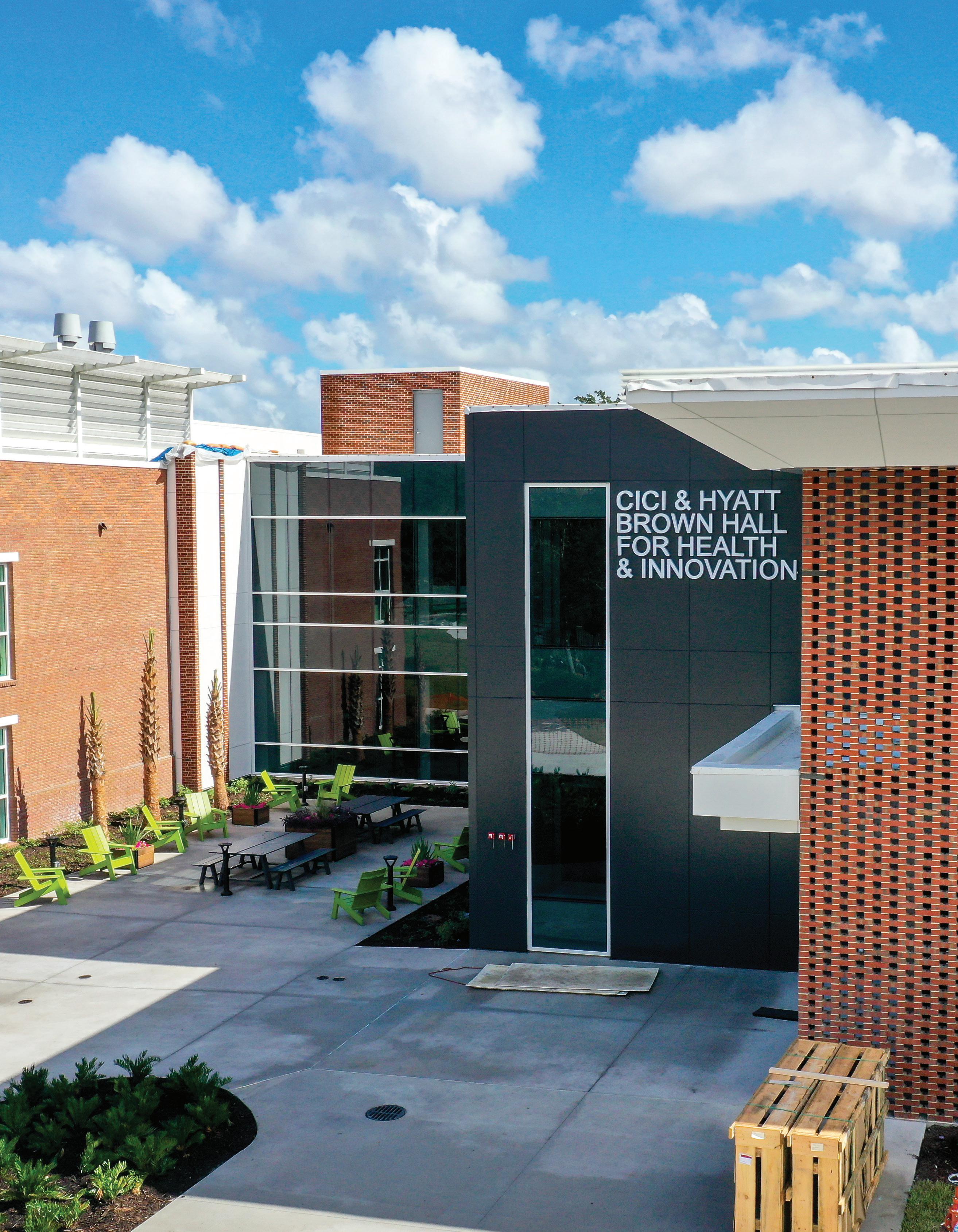 Story by: Chase Burger Photos by: Cas Bradley Layout by: Madeline Turnbull
Story by: Chase Burger Photos by: Cas Bradley Layout by: Madeline Turnbull
For months, the construction zone located just o the Stetson Green has been a nuisance for students, leaving them with fewer parking spaces and forcing their daily treks to class to be circumnavigated by fences. However, Stetson University heralded great news on September 19: the construction of the Cici & Hyatt Brown Hall for Health & Innovation would be coming to a close. e completion of the building is not only an achievement for the science program but for the school as a whole.
In April of 2018, Stetson University received its largest single gi in the school’s history. e gi —an $18 million donation—was given to Stetson by Hyatt and Cici Brown, who are longtime trustees and supporters of the university. e donation was to be used to fund the construction of a new science building on the DeLand campus and expand the science programs. At the ceremony, Wendy Libby said the donation came at just the right time, as Sage Hall was nearing operating capacity.
When announcing their donation, Cici Brown said, “sciences and health are an area that Hyatt and I have really become focused on for a number of reasons.” She explained that one of those reasons was that the couple believed Stetson University had the potential to be the place to allow students to prepare for careers in the elds of science and health. Hyatt Brown notoriously called the nancial contribution “an investment in the future.”
Stetson Today said the contribution “will help Stetson continue to be one of the leading economic engines of West Volusia, creating jobs through the construction of a new building and in attracting the better-paying jobs that come with an educated workforce.”
Talk surrounding the new building was quiet until the university o cially announced its plans to construct the new science building and renovate the already existing one. e goal was to create a “science complex” to be utilized by students studying health sciences, environmental sciences, and other related elds. Monday, May 10, 2021, preparations for construction began with the closure of the parking lots behind the duPont-Ball Library and Sage Hall, and the installation of fences to separate the soon-to-be construction zone from the rest of campus.
As for the renovations of Sage Hall, those were to be started immediately a er the 2021 announcement. e school shared its plans to construct a new cluster of research labs, which would consist of four di erent research areas including cell and tissue culture research, and molecular and microscopy research.
The vertebrate anatomy teaching lab would be upgraded to include a fully segmented human 3D anatomy system called the Anatomage Table, and more student collaboration spaces would be implemented for both formal and informal settings.
We used a drone to get a birds-eye view of the Brown building!
Additionally, renovations were to include upgrades to mechanical, electrical, and plumbing systems infrastructure.

e university also shared its design vision for the new building. It would boast exible and transparent active-learning classrooms, wet teaching labs, an environmental eld studies mud room, small group breakout rooms, research pods, a SMART lab, a new Teaching kitchen and a Teaching/Community Garden and greenhouse.
According to Stetson Today, the school acknowledged that the construction would create inconveniences for those on campus, but they said there was “a good plan” in place for vehicles and pedestrians that would need to be detoured in and around the site. Pedestrian Detour maps were to be distributed to the community. Stetson Today reported the administration learned that faculty and sta were interested in the campus becoming more pedestrian-friendly. e university claimed a good portion of the campus community happily anticipated more green space despite losing a majority of the Sage Hall parking lot.
Construction o cially began a er the university hosted a groundbreaking ceremony on Friday, June 11, 2021. e building was scheduled to be completed for the Fall 2022 semester. However, the nal beam was placed seven months later on January 7, 2022. is meant the 40,153 gross square feet structure was now set to be completed sometime in late November. e Dean of the College of Arts and Sciences, Elizabeth Skomp, PhD, cited the delays as supply chain issues. “At an earlier point in the process, certainly supply chain issues—which [are] involved [in] I think every construction project everywhere—were in play. At the outset of the project, there had been the hope that we would be open for Fall 2022. And then for some time now, we focused on November 2022 as the opening with January 2023 as the rst semester when we’ll have classes in the building,” Skomp explained.
With Sage Hall renovations completed in August 2021, Scott acker, associate vice president of Facilities Management, joyously announced on Sep-


tember 19, 2022, that the Cici & Hyatt Brown Hall for Health & Innovation was nearing completion “on schedule and under budget.” Skomp believes Cici and Hyatt Brown, who have been involved in a majority of the project, are just as excited. “ e Browns have been tremendously supportive of the project, and supportive of the vision as it unfolded. And my sense is that they are really enthusiastically optimistic about the opening of the building and the possibilities that it will bring,” Skomp said. Elana Sciavally ‘23, a chemistry major and lab assistant, is excited about the new development. “I think it’ll be nice to have everyone more spread out because there are only so many places in Sage currently that you can study, and most of the time there are always people there,” she said, adding, “I think that the new building and [increased] support for students in health sciences will contribute a lot for those going for an education within that department.”
President Christopher F. Roellke, PhD, has been one of the loudest supporters of the new science building. He concluded the 2021 groundbreaking ceremony by deeming it monumental. Skomp fully echoes his sentiments. “I think it’s truly a tremendous opportunity,” she told e Reporter. “I’m absolutely thrilled that the Browns’ vision and generosity is giving us the opportunity to have some new dynamic space that promotes collaboration. And it’s going to give students wonderful opportunities. … Our hope, in addition to that, is that it’s not only a space that is utilized by those [science] departments and programs, but really that it’s going to be an inviting space bringing in others from across the College of Arts and Sciences, but also the university as a whole. It is part of Stetson.”
“It is a big deal for Stetson. It is a big deal for DeLand. It is a big deal for Volusia County. It is a big deal for the state of Florida. And, of course, it is a huge deal for our students and our faculty who are going to occupy this first-rate facility to solve some of our most pressing challenges,” Roellke said.
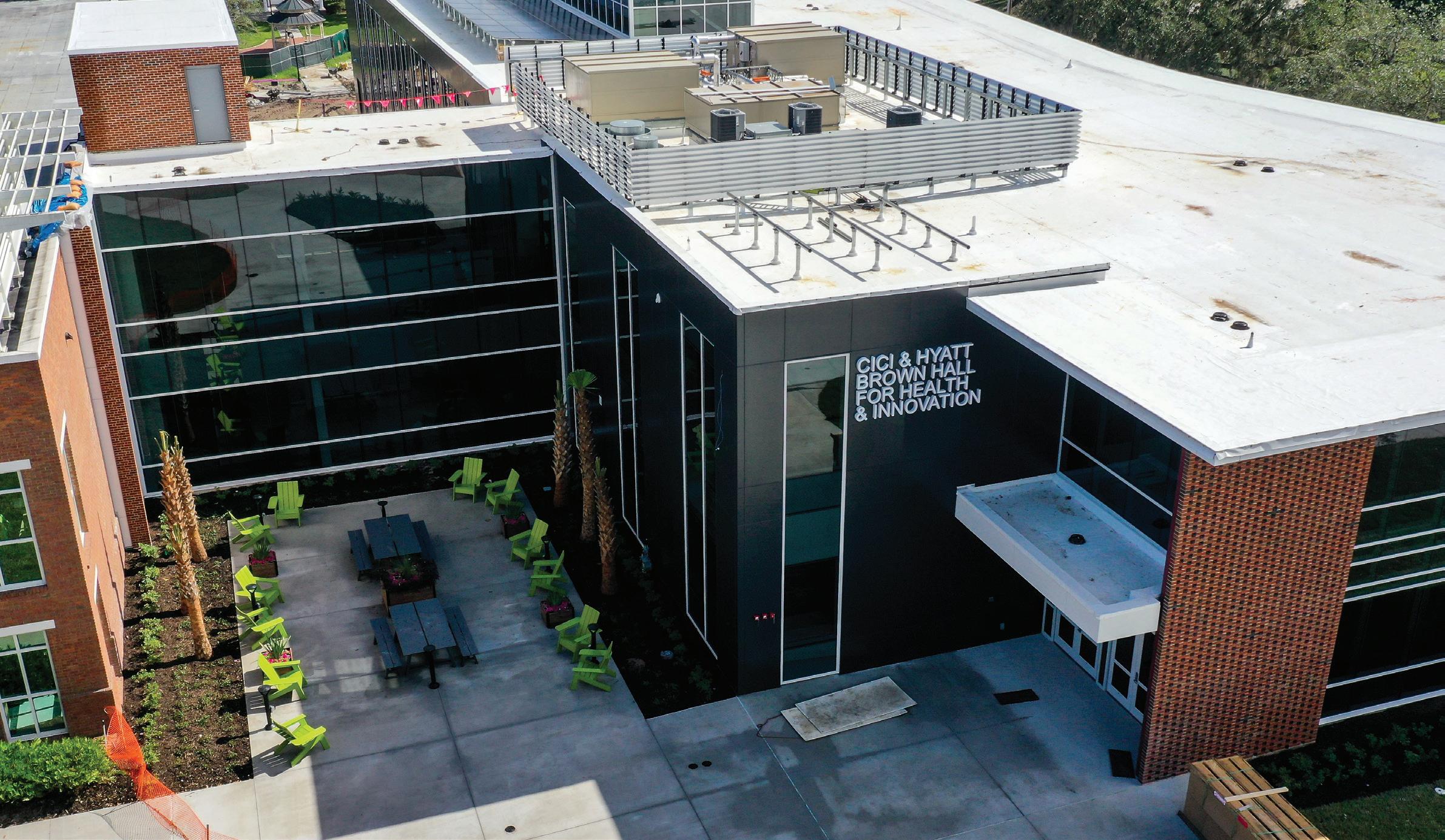






























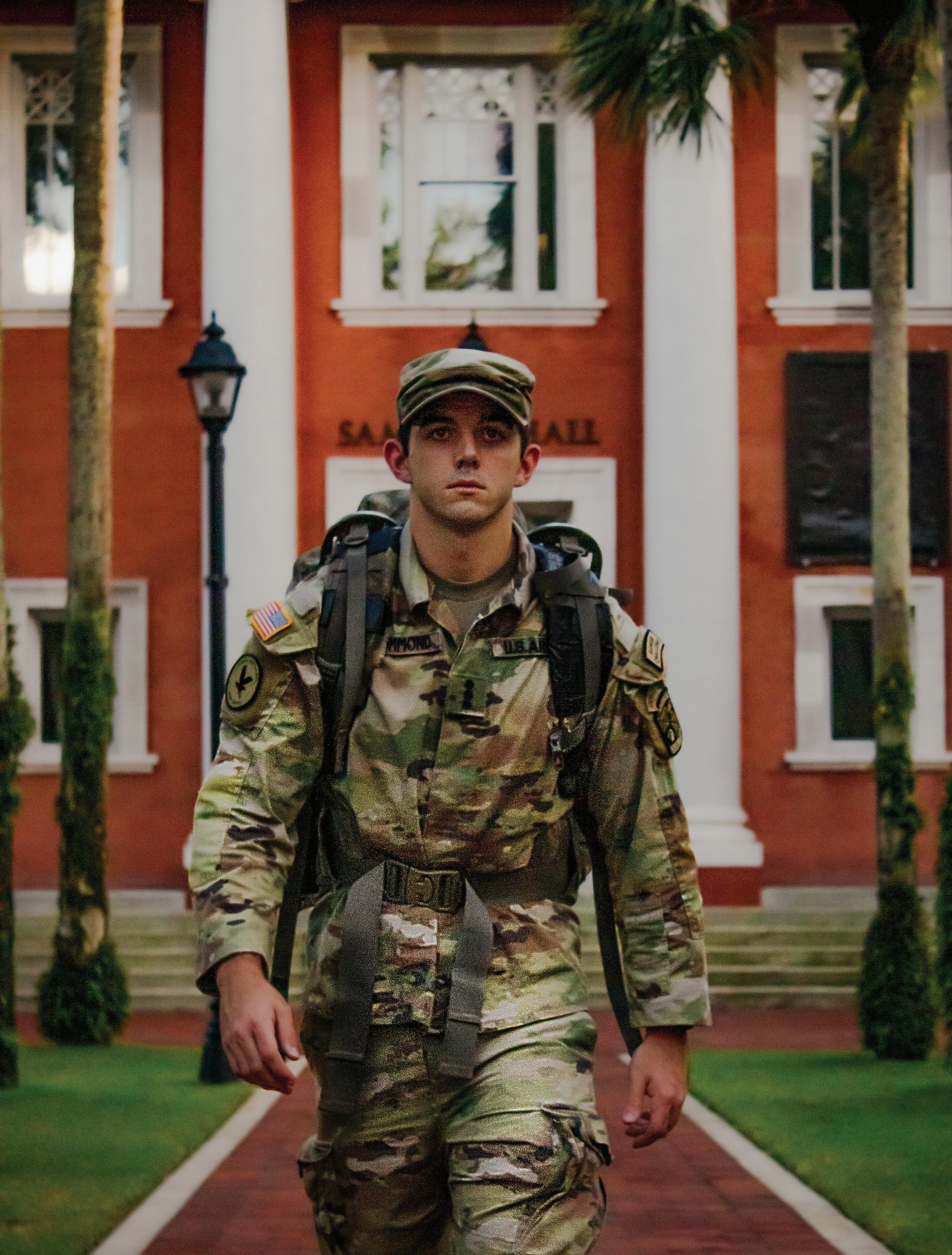 With Charles Issac Drummond
Story by Kaelyn-Rose Miranda Design by Cas Bradley
With Charles Issac Drummond
Story by Kaelyn-Rose Miranda Design by Cas Bradley
Charles
through the essential items he brings with him on a Field Training Exercise (FTX). FTX is a weekend long coordinated training exercise conducted at the end of every semester. Cadets implement lessons learned in their military science class that include conducting squad and platoon level operations in a tactical environment. These training sessions prepare cadets for advanced camp held in Fort Knox, Kentucky where cadet’s are graded on their potential to serve in the Army as a commissioned officer.
“I always have my toiletry gear. Cleanliness in the field is really important. It’s not like a regular day where you can shower: you’re getting hot, you’re getting sweaty, and you’re constantly working.”
“I always carry an extra set of OCP (operational camouflage pattern) uniforms and underclothes, just in case I go through water and bad terrain.”


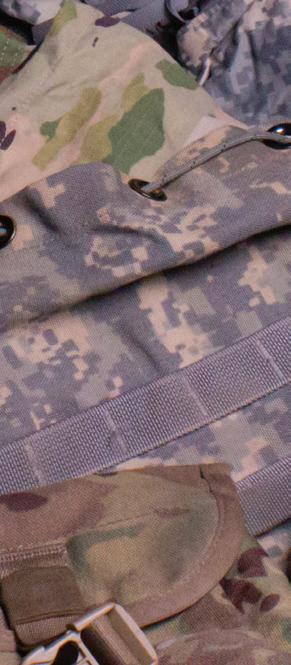



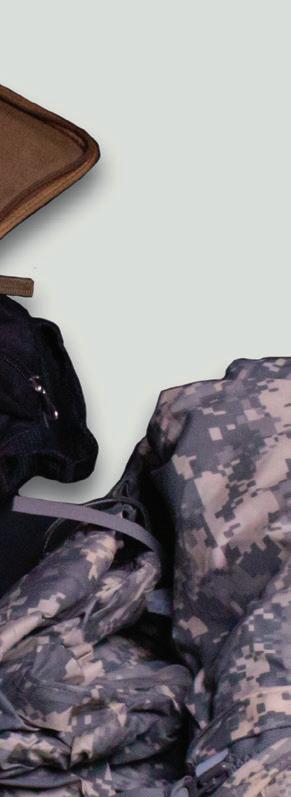
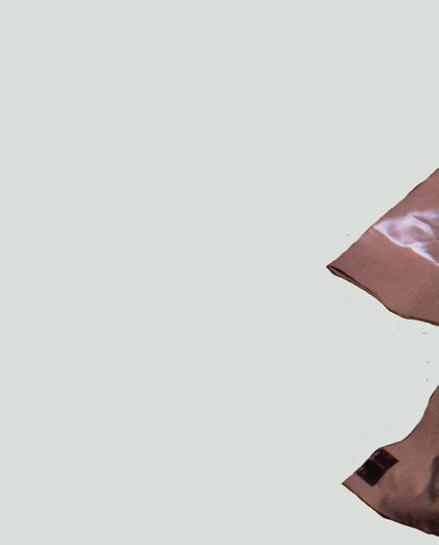
“An E-Tool is an entrenching tool. It’s like a collapsible shovel and that’s how we can build hasty defenses and dig fighting holes.”


“Basically it’s a guide book that has all my information that I could ever need for any type of operation, like setting up a defense or an attack. It has my nine-line medevac card which is used if somebody gets injured.”


“A lot of people like to be minimalist with this; I prefer comfort, so I don’t mind the extra weight. I carry my sleeping bag [and] my bivy cover, which is basically almost like a waterproof bag that the sleeping bag fits into. And then I also carry my ground mat, which is like an inflatable pad that you can lay on the ground and it makes it much more comfortable. A lot of people carry one of those three items. I carry all three of the sleep system components just because comfort for me is much more important.”
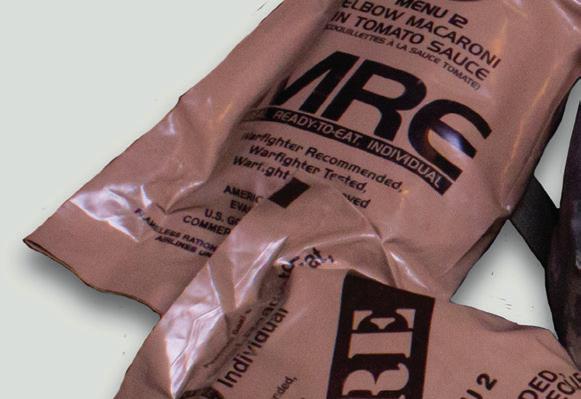
“I always have my kevlar, which is an army helmet, kind of like a steel pot, but it’s near bulletproof. We wear that anytime we’re doing any kind of operation.”




“I always carry a poncho and my entire set of rain gear, so pants and jacket. It just makes life in the field so much more comfortable because you at least have some protection while walking through the rain.”
“The ruck is used for all the equipment we carry when we’re out on the field. During our field training exercises we conduct missions at Camp Blanding (Florida Army National Guard Training Center) so we can do anything from a recon to attack and raids.”
Issac Drummond ‘23 Cadet Captain of Army ROTC Charlie Company goes



















Collegiate athletes have long been considered amateurs, however, critics argue that student-athletes should be able to receive some of the same bene ts as professionals. Some believe athletes are already compensated through the academic scholarships they are provided with, while others think they should be eligible for agents and brand deals. No matter the form of payment, the athletic world is faced with the ultimate task of deciding where the line is drawn to establish a rm separation between amateur and professional sports.
e NCAA temporarily suspended its rules, which prohibited bene ts from NIL, in June of 2021, now giving student-athletes the opportunity to seek compensation outside of regular employment standards. While schools have reaped the nancial bene ts from the name, image, and likeness of their popular athletes
for decades, students are now allowed to earn compensation of their own through partnerships, sponsorships, and becoming social media in uencers. NCAA o cials are currently working with Congress to develop clearer policies that support student-athletes and still deter pay-for-play scenarios at the collegiate level. In the meantime, states and institutions have set their own rules in place to regulate NIL deals.
Stetson University currently adopts the NIL rules in place by Florida Law. ese rules state athletes can participate in NIL activities, as long as they are not receiving compensation for their athletic performances, or a liation with a particular school. Institutions are also prohibited from developing standards imposing restrictions on students earning compensation from third party entities, nor can they provide compensation to the athletes themselves.
ACCORDING TO THE NCAA, NAME, IMAGE, LIKENESS NIL IS “AN ACTIVITY THAT INVOLVES THE USE OF AN INDIVIDUAL’S NAME, IMAGE, AND LIKENESS FOR COMMERCIAL OR PROMOTIONAL PURPOSES.”
“At Stetson, student-athletes are required to report their NIL activities through the Name, Image, and Likeness approval form located in ARMS an information management system.
Although we are not required to approve the activity, we have asked for submission prior to engaging in an effort to provide guidance related to if the activity would negatively impact the student-athletes eligibility.”
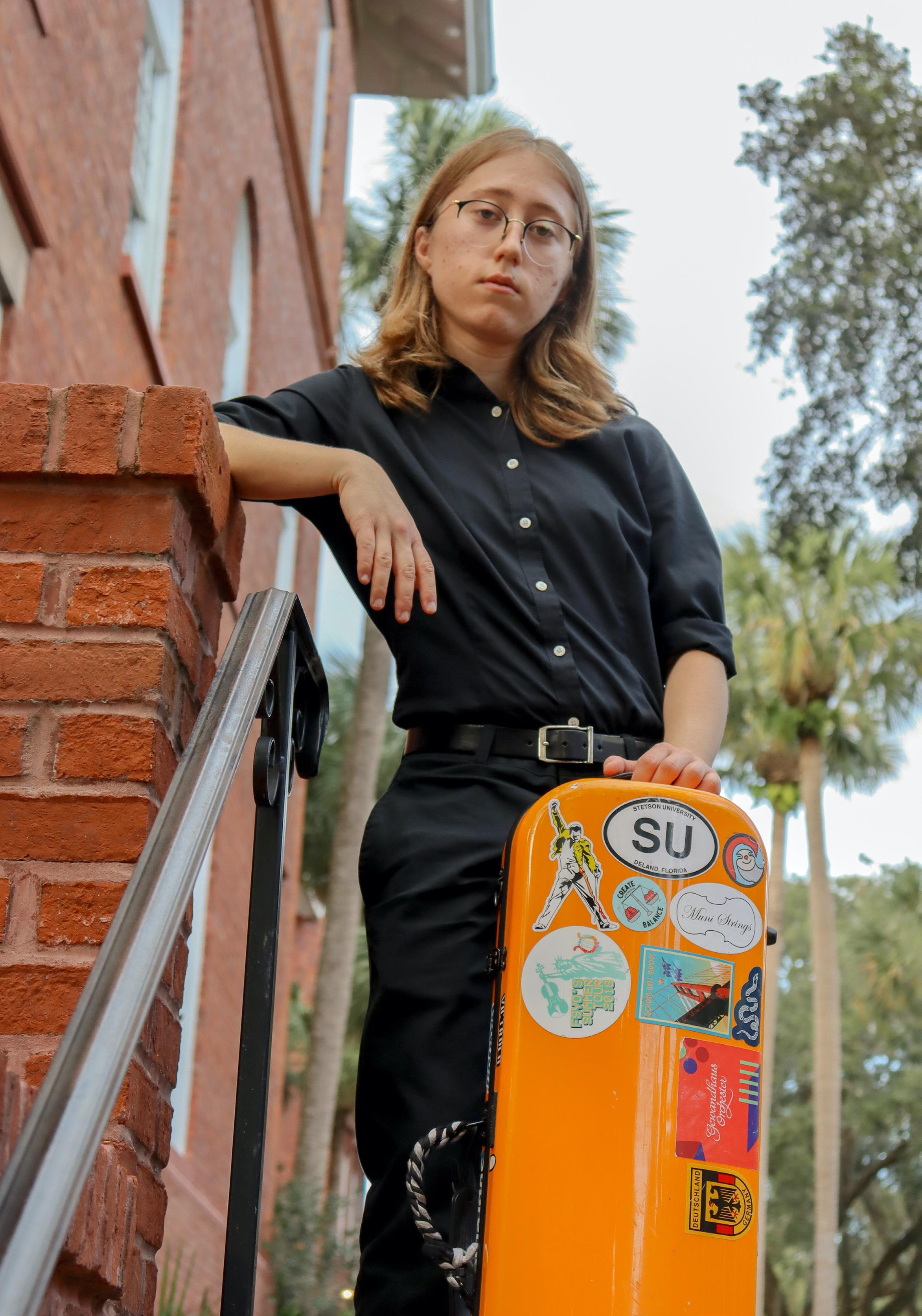
My dad is a professional cellist, and he would take me to his concerts and even rehearsals when I was a little kid. One time, I must have been two or three, so you can imagine that’s not a very good age to take your kid to a quartet rehearsal. I just did not let them rehearse because I was running around screaming the entire time. I wanted to play the oboe, it was the first thing that stood out to me. I was like “I want to play that one dad,” and he said “no, you don’t”. He didn’t want me to play the oboe and I never did, I never touched an oboe. But around eight I started asking for violin lessons but I didn’t get them until I was 11, because we couldn’t afford them. I finally got some lessons with a friend of my dad’s who lived close by until the end of high school.
What has been your hardest challenge as a musician?
Such a broad question. Every day is a challenge. Every day I struggle, and I question whether I should be doing this. Maybe I should quit.
Do you think that most musicians can relate to that?
Probably, because it’s a struggle when you’re thinking about it seriously as a career, are you going to make it? It’s a very competitive field to be in or to go into. I have backup plans, maybe I should work on a dairy farm. For performance, most people don’t immediately go into their career, a lot of them have to build up their careers for a few years before they get to be in an orchestra, for example, which is what I want to do.
So do you think then that your hardest challenge is not knowing what’s gonna happen?
Yeah, the uncertainty of the future. I can make as many plans as I want to, but that doesn’t mean that’s gonna happen because certain situations might arise where I can’t do certain things, maybe I’ll get carpal tunnel or I’ll break my wrist and I won’t be able to play anymore.
What would you consider your creative process when learning a new piece? What do you want to transmit and how do you get to that?
Ideally, what the composer is trying to convey, like for Mozart, it’s very much centered around what the composer and the style demand, it’s almost not about what you want. But even then in recordings of a Mozart concerto, you can pick out the styles of playing like Hillary Han’s style versus Itzhak Perlman’s style. They’re very different, kind of trademark sounds.
What’s Olivia’s trademark?
I want a trademark sound. There are some that I like, but you can’t just copy someone’s down. I believe in mimicry as a form of appreciation, because you can’t learn otherwise, you can’t form your style without first knowing what you like, then you can make your own. If you don’t know already what “good” sounds like and what your opinions are around certain styles of interpretation or certain sounds, then you won’t properly be able to make your own unless you have some sort of base knowledge of what that is.











What does this competition mean to you?
A: This is not a measure of who’s best, It’s a measure of who’s fit for it, a matter of preparation. And it feels good when you’ve prepared it so well that you win. But at the same time, there are always improvements to be made. It’s an accomplishment for sure. It’s a good thing.
Will this be your first experience playing with an orchestra?
Symphony Orchestra? Yes. I played with the chamber orchestra that my dad helped to cofound in Daytona, Daytona Solinsky Chamber Orchestra.
How did you feel before and after the competition?
Before? Dear Lord, kill me. After this? Not overwhelmingly happy, but satisfied. Okay, it’s done, thank God I can go eat chocolate now.
How did you feel when you found out you won?
Crazy, because there’s a lot of responsibility attached now. I have to play in November again and you have to hold yourself up more, you can’t say I’m done now I can move on, so there’s that added stressor, but it’s a good problem to have in the long run, I won a competition. It’s an honor.
Do you think that music can make a social change?
Absolutely, because it has in the past. For instance, Shostakovich. Shostakovich composed his ninth symphony over a few months; he said publicly I’m going to compose a symphony to commemorate our defeat of the Nazis in WWII and it’s going to be this wonderful thing. Stalin is at the premiere, and all these very dangerous and intimidating figures and they listened to it like, what is this? Because there’s no majesty, it’s not triumphant, it’s more like a silly joke. He said publicly this is supposed to celebrate our victory in WWII against the Nazis, but in reality he was making fun of the regime for how ridiculous it was, and how bad it was. But it’s something that people could see then and now, the public dissent of the common opinion has been used in music since it existed.

As any DeLandite could attest, this town is rich with prime pizza places. But with so many to choose from, it can be di cult to distinguish between them. Who has the best prices? Which tastes the best? Most of all, who has the time to gure that out? at’s why we went on a quest to nd you the answers you deserve. We scoured high and low, and whittled the pool of applicants down to a top three. Of those that remained, we ranked them from least best to best based on our experience at each. To keep the competition fair, we ordered a 14 inch cheese pizza and a signature appetizer for comparison’s sake. Here are the results from our investigation:
is local fav is smack dab in the center of Mainstreet downtown. is contemporary classic serves up Italian inspired cuisine, so everything feels like a fresh take on all your favorites. We got the frittis as an appetizer, which were fried dough balls stu ed with mozzarella, topped with powdered sugar, and served with marinara. It sounds funky, and it is, but it’s also insanely delicious. Each bite had the perfect balance of sweet and savoriness, plus crunchy and gooeyness.
Since they’re always packed no matter when you go, we ended up sitting on the patio, which was remarkably lovely thanks to the overhead fans. e waitsta were dressed in black button ups and dress pants, which added a formal feel to the place. And an added bonus, the outdoor
area is dog friendly, so if you play your cards right you might get to pet a dachshund, too. e crust was so thin it felt more akin to a cracker, and the ingredients were clearly fresh. at being said, it was also surprisingly bland, which made it slightly more forgettable than our other picks. at and the fact that despite supposedly being the same 14 inches as the others, it felt smaller somehow, and had two less slices than the others to boot. And, given that this was the priciest pie on our list, coming in at a whopping $14, you don’t really feel like you get your money's worth proportionally. So, if you’re feeling fancy and want a bougie take on a nostalgic favorite, then this one’s your go-to.
The pizza itself felt like an elevated version of what you’d expect.



is one’s about a 15-minute drive from campus, tucked in the West Volusia Regional Shopping Center. It’s a well known go-to for Italian food connoisseurs, and since they offer more of a New Jersey take on the cuisine, it’s just di erent enough from the norm to be refreshing, but not so di erent that it doesn’t satisfy the craving. e pie was large and indulgent, and the copious amount of cheese oozed with every bite.


While the sta was friendly, and the decor made for a homey environment, the crowd that it draws is re ective of the city at large, not quite the eclectic and tolerant culture of Mainstreet downtown. Basically, if you don’t feel comfortable in areas farther from campus, but you still want tasty pizza, then you might consider just ordering takeout here. In all fairness, this is what the majority of people do regardless, because even on a Tuesday night it took us a good two hours to get in and out.
A fun plus is their selection of specialty sodas and san pellegrino, not to mention their cookies and desserts.
If you’re looking for a treat-yo-self kinda joint for a solid night in, this is the one for you.
We loved how they towed the line of classic and new, like with their fried raviolis, which packed a flavorful punch.

Planted on a prime corner in downtown DeLand sits this absolute cult classic. is one’s an all arounder folks—it’s within walking distance of campus, their portions are generous, the sta are friendly, the ambiance is inviting, and at $11.99 for a 14 inch cheese pizza, it’s also the cheapest option on our list. But the biggest thing that set’s Tony’s apart from the competition is the quality of the pizza itself. is was by far the tastiest of the three; it had the most avor due to its sweet yet savory sauce, and it had plenty of cheese without being too salty. e crust was crispy and crunchy, so it didn’t op over limply when trying to eat it.


ey serve classic New York style pizza, evident by the quintessential avor as well as the brick walls and Italian ags everywhere. ere’s nothing haughty about this place, you could show up in a questionably suggestive anime shirt and slippers and no one would bat an eye. But that accessible vibe cultivates a welcoming atmosphere; I’d feel perfectly comfortable taking anyone here.
don’t try to reinvent the wheel, and sometimes that can be comforting. If you’re looking for a slam dunk, this is your spot.


















